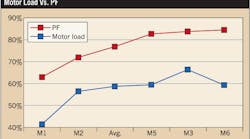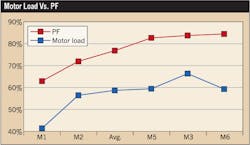Those four big 400HP motors that drive your air compressors are inductive loads that need their own power factor correction. If power factor at the load is 80%, that means you can’t use 20% of the power you paid for!
Now, suppose you go out to the motor with a power analyzer, and you find a 15% inductive lag. You do the calculations to determine the capacitor size needed to get close to unity and then get those installed. A month later, the energy auditor your company hired reports that the capacitors are too large, and consequently there’s a considerable lead past unity. Why would this be?
The two of you measured PF at different phases of the compressor’s operation. If the motor isn’t driving a particularly heavy load, it’s using less power, so its PF is low. But a heavy load means it will draw more power, so PF increases.
Does that seem backward to you? It’s not. To determine PF, you divide the working power (kW) by the apparent power (kVA). The apparent power is the measured current times the applied voltage. Pretty simple. It doesn’t account for the magnetizing current. But working power does.
In the vector math explanation of this, PF is the cosine of the angle between working power and apparent power. So at low load, there’s little actual electrical power (watts) required to rotate the motor. Thus, power factor is low because the resistive component is small relative to the inductance. During the compressor’s loading phase, the motor draws much more current and its resistive component increases relative to the inductance so PF goes up.
If you have a situation like this, look into a variable frequency drive (VFD) with PF correction.
Sometimes, a motor is oversized for the application. That also means a light load and thus lower PF. The oversizing is often due to needing enough torque at one point of the operation (for example, starting up the process when fluids are more viscous than they are after the motor is running for a while). If you can’t adjust operating practices, look into a gear box that will reduce the torque enough to use a smaller motor.
Correcting PF at the load, particularly at large motors, can produce significant energy savings. But be aware of potentially complicating factors. When you encounter them, you will probably find a solution in mechanical gearbox on the output or a VFD on the input. Or both.
You can’t fix what you can’t measure. Make sure you’re measuring the PF on all of your large inductive loads. As you correct PF, you will extend the life of the utilization equipment and the power distribution system while lowering your utility bill.





